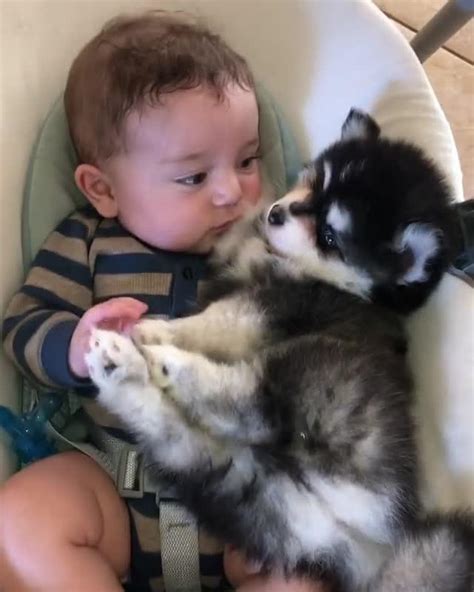
A heartwarming video circulating online shows a dog owner comforting his frightened husky during a recent thunderstorm, providing a soothing display of affection that has resonated with viewers and underscores the strong bond between humans and their pets. The clip, shared widely across social media platforms, features the unidentified man gently cuddling and reassuring his anxious canine companion, offering a touching glimpse into the lengths pet owners go to alleviate their animals’ distress.
Dog Dad’s Affectionate Response to Husky’s Thunderstorm Anxiety
The viral video showcases a devoted dog owner responding to his husky’s fear of thunderstorms with unwavering comfort and affection. In the face of loud thunder and disruptive lightning, the dog dad is seen providing the scared husky with close physical comfort and gentle reassurance, effectively mitigating the animal’s anxiety. The video has touched the hearts of many viewers online, emphasizing the significant emotional support pets provide and the reciprocal care they often receive.
The footage captures the husky, visibly distressed by the storm, seeking solace from its owner. The man responds by embracing the dog closely, stroking its fur, and speaking to it in a calming tone. This interaction underscores the profound emotional connection that can develop between humans and their pets, illustrating how animals become integral members of the family, deserving of care and emotional support during times of distress.
The viral video provides a poignant reminder of the anxiety that thunderstorms can induce in pets. Loud noises and sudden bright flashes of light often trigger fear responses in animals, leading to behaviors such as pacing, panting, hiding, and even destructive actions. The dog owner’s reaction not only offers immediate relief to the husky but also serves as an example to other pet owners on how to effectively address their pets’ fears during similar situations.
Understanding Thunderstorm Phobia in Dogs
Thunderstorm phobia, also known as astraphobia, is a common anxiety disorder affecting dogs. The exact causes of this phobia are not fully understood, but likely involve a combination of genetic predispositions, learned experiences, and sensory sensitivities. Dogs may develop a fear of thunderstorms due to the loud noises, changes in barometric pressure, static electricity, and even the smell of ozone in the air.
According to animal behaviorists, dogs possess more sensitive hearing than humans, making them particularly vulnerable to the jarring sounds of thunder. Additionally, changes in atmospheric pressure and static electricity can create discomfort for dogs, further exacerbating their anxiety. Some dogs may also associate thunderstorms with negative experiences, such as being left alone or feeling trapped during a storm.
Symptoms of thunderstorm phobia can range from mild anxiety to severe panic. Mildly affected dogs may exhibit signs of restlessness, panting, and seeking attention from their owners. More severely affected dogs may hide, tremble, drool excessively, bark incessantly, attempt to escape, or even become destructive. In some cases, dogs may injure themselves while trying to find a safe place to hide.
Recognizing the signs of thunderstorm phobia is crucial for pet owners to provide appropriate support and intervention. Early intervention can help prevent the phobia from escalating and improve the dog’s overall quality of life. By implementing strategies to reduce their dog’s anxiety, owners can create a more comfortable and secure environment during thunderstorms.
Strategies for Comforting Anxious Dogs During Thunderstorms
There are several strategies that pet owners can use to help comfort their dogs during thunderstorms. These strategies aim to create a safe and secure environment, reduce sensory stimulation, and provide reassurance to the anxious animal.
One of the most effective strategies is to create a safe haven for the dog. This can be a designated area in the home where the dog feels secure and protected. The safe haven should be comfortable, quiet, and easily accessible to the dog. It can be a crate, a bed, or even a closet. Providing the dog with familiar toys, blankets, and treats can further enhance the sense of security.
During a thunderstorm, it is important to remain calm and reassuring. Dogs are highly sensitive to their owners’ emotions and can pick up on signs of anxiety or stress. Speaking to the dog in a soothing voice and providing gentle physical contact can help to calm its nerves. Avoid coddling the dog excessively, as this can inadvertently reinforce its fear.
Reducing sensory stimulation is another key strategy for managing thunderstorm phobia. Close the windows and curtains to block out the sight of lightning and reduce the sound of thunder. Playing calming music or using a white noise machine can also help to mask the disruptive sounds of the storm. Some dogs may benefit from wearing a pressure wrap, such as a Thundershirt, which applies gentle pressure to the body and can have a calming effect.
In severe cases of thunderstorm phobia, medication may be necessary to manage the dog’s anxiety. Anti-anxiety medications, such as selective serotonin reuptake inhibitors (SSRIs) or benzodiazepines, can help to reduce the dog’s fear response and improve its overall well-being. These medications should only be administered under the guidance of a veterinarian or veterinary behaviorist.
Long-Term Management of Thunderstorm Phobia
In addition to providing immediate comfort during thunderstorms, long-term management strategies can help to reduce the dog’s anxiety over time. These strategies include desensitization and counterconditioning, which aim to gradually expose the dog to thunderstorm-related stimuli in a controlled and positive manner.
Desensitization involves exposing the dog to recordings of thunder at a low volume while providing positive reinforcement, such as treats or praise. Gradually, the volume of the thunder recordings is increased as the dog becomes more comfortable. Counterconditioning involves associating the sound of thunder with positive experiences, such as playing games or receiving special treats.
Consistency and patience are essential for successful desensitization and counterconditioning. The process may take several weeks or months to complete, and it is important to proceed at the dog’s pace. If the dog shows signs of anxiety during the training process, it is important to back off and reduce the intensity of the stimuli.
Working with a certified dog trainer or veterinary behaviorist can be highly beneficial in developing a comprehensive management plan for thunderstorm phobia. These professionals can provide guidance on desensitization and counterconditioning techniques, as well as recommend appropriate medications or other therapies.
The Importance of Emotional Support for Pets
The viral video of the dog owner comforting his husky highlights the importance of providing emotional support for pets, especially during times of distress. Pets rely on their owners for safety, security, and comfort, and it is our responsibility to provide them with the care and support they need.
Animals enrich our lives in countless ways. They provide companionship, reduce stress, and offer unconditional love and support. In return, they deserve our care and attention, especially when they are feeling vulnerable or afraid.
By understanding the causes of thunderstorm phobia and implementing effective management strategies, pet owners can help to improve the quality of life for their furry companions. Creating a safe and secure environment, reducing sensory stimulation, and providing reassurance are all essential components of effective thunderstorm phobia management.
The viral video serves as a powerful reminder of the profound bond between humans and their pets, and the importance of providing emotional support to those who depend on us. By offering comfort and understanding, we can help our pets overcome their fears and live happy, healthy lives.
The Broader Impact of Viral Pet Videos
The circulation of videos like this extends beyond mere entertainment, playing a role in raising awareness about pet anxiety and responsible pet ownership. When heartwarming instances of human-animal interaction go viral, they encourage others to consider how they might better support their own pets through stressful events.
Moreover, these videos contribute to a broader cultural recognition of the emotional and psychological complexities of animals. As more people witness the depth of the bond between humans and their pets, there is an increased understanding of the importance of treating animals with compassion and respect.
Viral pet videos can also indirectly influence pet care practices. When viewers see effective strategies for managing pet anxiety, they may be more inclined to adopt similar approaches in their own homes. This can lead to a more widespread adoption of positive reinforcement techniques and a greater emphasis on creating enriching environments for pets.
The Role of Social Media in Sharing Pet-Related Content
Social media platforms have become invaluable tools for sharing pet-related content, including heartwarming videos, educational resources, and advocacy campaigns. These platforms provide a vast and accessible audience for reaching pet owners and animal lovers around the world.
Viral pet videos often originate on platforms such as YouTube, Facebook, Instagram, and TikTok, where they are quickly shared and viewed by millions of users. The algorithms of these platforms can amplify the reach of these videos, ensuring that they reach a diverse audience of people with varying levels of experience with pets.
In addition to sharing videos, social media platforms can also be used to connect pet owners with valuable resources, such as articles on pet health and behavior, lists of local veterinarians and trainers, and information on pet adoption. Social media groups and forums can provide a supportive community for pet owners to share their experiences, ask questions, and offer advice.
Social media also plays a crucial role in advocating for animal welfare. Organizations and individuals can use these platforms to raise awareness about issues such as animal abuse, neglect, and overpopulation, and to promote responsible pet ownership practices.
The Science Behind Animal Comfort and Anxiety
The actions demonstrated in the viral video align with scientific understanding of how animals experience and respond to stress and comfort. Studies in animal behavior and psychology confirm that physical touch and gentle vocalizations can significantly reduce anxiety in dogs. The release of oxytocin, often referred to as the “love hormone,” is stimulated through physical contact, promoting feelings of calm and security in both the human and the animal.
Moreover, the husky’s breed characteristics contribute to its particular sensitivity to environmental stressors. Huskies are known for their intelligence and keen awareness of their surroundings, which can make them more prone to anxiety when faced with unpredictable and intense stimuli like thunderstorms. Understanding these breed-specific traits can help owners tailor their responses to better meet their pet’s needs.
Research also indicates that the consistency and predictability of an owner’s response to their pet’s anxiety can play a critical role in mitigating long-term stress. When a dog consistently receives comfort and reassurance during stressful events, it learns to associate those events with positive interactions, reducing the likelihood of developing severe phobias.
Legal and Ethical Considerations in Pet Ownership
Responsible pet ownership extends beyond providing basic needs such as food, water, and shelter. It also encompasses a commitment to ensuring the animal’s emotional and psychological well-being. This includes providing adequate mental stimulation, socialization opportunities, and access to veterinary care.
In many jurisdictions, pet owners have a legal obligation to provide their animals with a safe and healthy environment. This may include laws related to animal cruelty, neglect, and abandonment. Failure to meet these obligations can result in fines, imprisonment, or the loss of the animal.
Ethical considerations also play a significant role in responsible pet ownership. Pet owners have a moral obligation to treat their animals with respect, compassion, and kindness. This includes avoiding practices that cause unnecessary pain or suffering, such as chaining or prolonged confinement.
Furthermore, pet owners should be mindful of the potential impact of their actions on the wider community. This includes preventing their animals from causing disturbances to neighbors, such as excessive barking, and cleaning up after them in public spaces.
Conclusion: A Testament to the Human-Animal Bond
The heartwarming video of the dog owner comforting his husky is a testament to the profound bond that can exist between humans and animals. It underscores the importance of providing emotional support for pets, especially during times of distress, and serves as a reminder of the reciprocal nature of the human-animal relationship. By understanding the causes of pet anxiety and implementing effective management strategies, pet owners can help to improve the quality of life for their furry companions and strengthen the bonds that unite them. The viral video’s impact goes beyond a fleeting moment of entertainment; it fosters a deeper understanding of animal emotions and promotes responsible, compassionate pet ownership.
Frequently Asked Questions (FAQ):
1. What is thunderstorm phobia in dogs, and what are its symptoms?
Thunderstorm phobia, also known as astraphobia, is an anxiety disorder in dogs characterized by a fear of thunderstorms. Symptoms can range from mild restlessness, panting, and seeking attention to more severe reactions such as hiding, trembling, drooling excessively, barking incessantly, attempting to escape, or even destructive behavior. The phobia can be triggered by loud noises, changes in barometric pressure, static electricity, and the smell of ozone.
2. What can pet owners do to comfort their dogs during thunderstorms?
Pet owners can employ several strategies to comfort their dogs during thunderstorms. These include creating a safe haven for the dog, remaining calm and reassuring, reducing sensory stimulation by closing windows and playing calming music, and, in severe cases, consulting with a veterinarian about anti-anxiety medication. Consistent and gentle physical contact can also help to calm the dog’s nerves.
3. How can long-term management strategies help dogs with thunderstorm phobia?
Long-term management strategies such as desensitization and counterconditioning can help reduce a dog’s anxiety over time. Desensitization involves gradually exposing the dog to thunderstorm-related stimuli (e.g., recordings of thunder) at a low volume while providing positive reinforcement. Counterconditioning involves associating the sound of thunder with positive experiences, such as treats or play. Consistency and patience are essential for these techniques to be effective.
4. Why are viral pet videos like this one important?
Viral pet videos are important because they raise awareness about pet anxiety, promote responsible pet ownership, and foster a deeper understanding of the emotional capabilities of animals. They can also indirectly influence pet care practices by showcasing effective strategies for managing pet anxiety and promoting positive reinforcement techniques. They help underscore the reciprocal bond between humans and animals.
5. What is the role of social media in sharing pet-related content and promoting animal welfare?
Social media platforms play a crucial role in sharing pet-related content and promoting animal welfare. They provide a vast and accessible audience for reaching pet owners and animal lovers around the world. Viral pet videos often originate on these platforms, and they can be used to connect pet owners with valuable resources, such as articles on pet health and behavior. Social media also plays a crucial role in advocating for animal welfare, raising awareness about issues such as animal abuse, neglect, and overpopulation.









